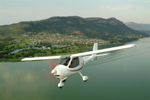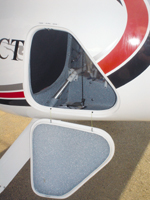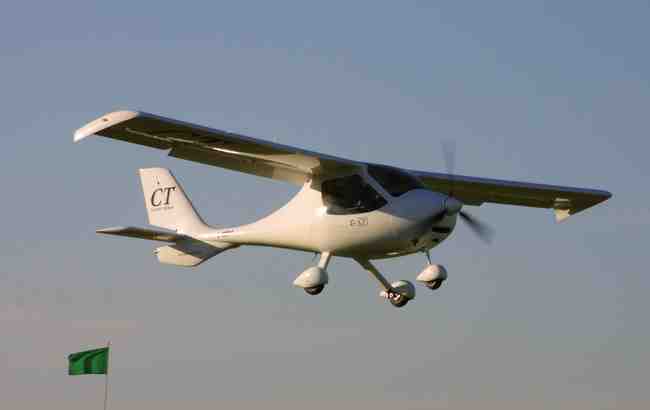|
 The
surge in ultralight sales in South Africa is set to continue with
the Ukrainian-manufactured CTSW. Designed, marketed and sold from
Germany, the CTSW is a remarkably competent design with an amazing
range and useful cruise speed. Two have already been sold in SA - we
test flew one of them shortly after customer delivery. The
surge in ultralight sales in South Africa is set to continue with
the Ukrainian-manufactured CTSW. Designed, marketed and sold from
Germany, the CTSW is a remarkably competent design with an amazing
range and useful cruise speed. Two have already been sold in SA - we
test flew one of them shortly after customer delivery.
The explosion in Very Light
Aircraft popularity continues with the recent import of a pair of
Flight Design CTSW ultralights from Germany.
The agency has been snapped up by
Paradise Beach specialist Elmo de Witt who has already established a
distributorship for the Czech-built Jora aircraft. The CTSW is the
original creation of scholars from the University of Frankfurt who
designed the CT2K-version of the aeroplane as part of their
aeronautical design study thesis. It first flew in 1985. It appears
that the design languished for over ten years or so until spotted by
German entrepreneur and aviation enthusiast, Matthias Betsch. In
1997, Betsch went into production and according to the company’s
pamphlets, over 300 variants have been delivered to date.
The ‘SW’ version was introduced in
1999 and Flight Design claim some truly impressive numbers – the
most notable being the aeroplane’s amazing range on a tankful of gas
– indeed, one example has been flown between Germany and Greenland
in a much celebrated flight last year. Germany has some pretty tight
specification limits for this class of aircraft and the country is
an expensive location in which to build. Betsch has managed to bring
the cost down by shipping components to a Ukrainian factory, where
the CT is built some 200kms northeast of Odessa and then shipped
back to Germany ready for final assembly. Despite early reports of
poor finishing, the aircraft I flew appeared to have most of these
problems ironed out and Elmo’s demonstrator has obviously been
completed to a high standard.
The airframe is vacuum moulded and
is mostly carbon fibre rather than resin – indeed, Flight Design
claim some notable safety features including a certification
standard that allows the CT to be flown at up to 600kgs at gross
weight. Moreover, the fuel tanks have been positioned in each wing
and contain 130 litres giving a range of 1 100 nautical miles at a
cruise speed of 130 knots. The cantilever wings make use of large
flaps that spread across two thirds of the CT’s trailing edge. They
are five position flaps, electrically driven, with a
‘minus-12-degrees’ facility for the cruise configuration.
 The
‘moulded’ construction method has further provided another great
benefit – a large baggage bay that almost takes up the entire rear
fuselage area immediately behind the seats. Although it is not
accessible in flight, the bay can be accessed by either of two
hatches on each side of the fuselage and hey-ho … it’s big enough to
hold a tent and a pair of camping chairs – and even a lightweight
coolerbag plus soft luggage. Indeed the CT has an almost Tardis-like
quality – looking deceptively small, the cabin is vast with plenty
of headroom, legroom and shoulderoom that would almost put a Cessna
182 to shame. The
‘moulded’ construction method has further provided another great
benefit – a large baggage bay that almost takes up the entire rear
fuselage area immediately behind the seats. Although it is not
accessible in flight, the bay can be accessed by either of two
hatches on each side of the fuselage and hey-ho … it’s big enough to
hold a tent and a pair of camping chairs – and even a lightweight
coolerbag plus soft luggage. Indeed the CT has an almost Tardis-like
quality – looking deceptively small, the cabin is vast with plenty
of headroom, legroom and shoulderoom that would almost put a Cessna
182 to shame.
An all-flying elevator provides
pitch control with a cutout in the rudder to accommodate the flying
surfaces’ upwards travel.
A fin extension has been added to
the bottom of the fuselage boom for extra directional stability and
to protect the tail in the event of a tailstrike. Whilst the
interior may appear somewhat rudimentary at first glance, there are
some clever additions – most notable are the small hinged panels
beneath your legs.
These cover further stowage space
and can easily take some cooldrinks, maps and other paraphernalia
that occupants might require during a lengthy cross country trip.
The seats seemed comfortable enough and all the controls fall easily
to hand.
The most dominating structure is
without doubt the sizeable instrument ‘binnacle’, which has a
righthand side that is canted towards the pilot. Whilst the panel
itself will most likely be completed to individual pilot’s tastes,
there’s enough room for a full set of primary flight instruments.
Whilst Flight Design provide a series of analogue gauges as
standard, our demonstrator was fitted with an MGL Avionics
Stratomaster electronic box giving a digital readout of all
temperatures, pressures and other engine information including rpm.
A centre pedestal contains the electrical switch panel and circuit
breakers and a fuel shutoff lever that has to be in the open
position before the engine can be started. The magneto switch is key
activated just like your common or garden Cessna single.
At the pedestal’s base, four levers
control trim, choke, throttle and brake. They fall easily to hand,
though there might be risk of confusion despite Flight Design’s
colour coded layout. The nearest to the pilot is the glider-type
trim lever and next to that is the choke – only used when the Rotax
engine is started from cold. Next is the throttle and beyond that
the single brake lever. There are no toe brakes – a rarity in this
type of ultralight – however, the CT’s system works well even
though, to operate it, you are obliged to remove your hand from
something else that is important. On the landing rollout or indeed
during taxiing, I find it slightly disconcerting to take my hand
away from the throttle. Behind the levers there is a parking brake
and a welcome tray that will easily hold some pens or a packet of
smokes – even an Airfield By Appt Only guide.
Starting the 100hp Rotax is
typically painless and the engine burst into life at the flick of
the key. There is a fair amount of residual thrust from the brightly
finished Neuform composite propeller so the efficient parking brake
system is rather a neccessity. The CT gets underway by itself
without really needing a burst of power. Immediately apparent is the
lovely soft ride. Quite how Flight Design have achieved this is
difficult to say.
However, the tubular undercarriage
legs are attached to each other via a mid-fuselage inverted
‘U-shaped’ bracket rather than being merely fixed to the external
airframe with a supporting bracket.
I would imaging the setup would be
ideal for rough strips. The nosewheel is often a weak link in this
otherwise sturdy class of aeroplane and I was unable to take a close
look at the firewall structure. However, steering was relatively
light with good directional control through the rudder pedals.
With the pre-takeoff checks
complete and carrying first stage flaps of 15-degrees, the CT
accelerated briskly along Grand Central’s runway 17. The CT has
relatively short wings – a mere span of 8.5 metres, so I wasn’t
expecting any short field surprises. Moreover, the two of us, Elmo
and I, weighed some 200kgs and we had about 80 litres of fuel
aboard. It took about a quarter of FAGC’s runway to rotate on a
pretty hot afternoon – a great deal more impressive than a Cessna
150 or even a 172. We climbed out at about 750-800 feet per minute
at 70 mph. I also glanced over to the engine temperature readout as
some of these Rotax installations weren’t optimised for the high
ambient temperatures we get in South Africa. I was pleased to see
that the temps and pressures were well within the normal operating
range.
Once up to our cruise height of
about 6 500 feet, the airspeed leapt as soon as we activated the
‘negative’ flap setting. There was almost no need to input trim as
the aeroplane’s configuration and speed was adjusted but this is
also typical of these types of aircraft. Control harmonisation is
good with the rudder being somewhat heavier than the elevator and
ailerons. Indeed there is little rudder feel so those not used to
the CT will probably, like me, make continual reference to the turn
and slip indicator to keep the ball centralised. Roll input was met
by an instant response and the CT is immense fun to fly.
At our density altitude, the
airspeed indicator quickly rose to 130 mph at 5 100rpm. I would
suspect that the advertised 130 knots is not too far wrong,
especially as I had noted the CT was difficult to catch up with in
the Cessna 182 we had earlier used to carry out the air-to-air
photography session. I tried a few steep turns and the aircraft felt
solid and responsive, although an eye on the slip indicator was
needed to keep the ball in the middle. Visibility over the nose
isn’t too bad although the aircraft seems to fly nose-up – an
optical illusion caused by the lowish seating position and large
instrument housing. Upwards visibility is good for a high wing
design. However, the big doors, almost entirely covered by perspex
give the impression of great visibility – enhanced by the strutless
wings. The roof contains perspex panels between the spar covering
and help when making turns.
I put the aircraft through a couple
of stalls – one without flap and one carrying a little power with
full flap. The first configuration resulted in a very gentle roll
off to the right at the break and the next a somewhat sharper roll
off to the left. Both stalls were easy to recover from using power
and relaxing back pressure on the stick. Overall, the CTSW handled
very nicely indeed and it struck me that the aircraft would spring
no nasty surprises in all phases of flight. Although the aircraft
has been extensively spin tested, we didn’t explore that area of the
flight envelope.
We returned to Grand Central’s
circuit and giving the slippery little aeroplane plenty of room to
slow down, I reduced speed to 70mph in order to deploy the flaps.
70mph is somewhat low for an aircraft with this level of
performance, so entry into the circuit requires a little forward
planning. Whilst its speed is easily sufficient for it to mix with
far bigger aeroplanes, once settled into the approach at 60mph, the
maximum flap speed means that during the final approach phases,
there isn’t much speed to play with in a crowded circuit.
Nevertheless, the aircraft is stable on final approach. Pilots might
like to carry a smidgen of power into the flare as with full flap,
there is a lot of stick travel to get the nose up to keep the
nosewheel away from wheelbarrowing.
There’s plenty of elevator
authority though and quite a sharp movement between the
over-the-fence attitude and the landing attitude. In practice, this
would be OK for getting in and out of shorter strips but for longer
general aviation runways, only second stage flaps would be necessary
to make the final touchdown less of a sudden manipulation of the
stick.
The brakes are extremely powerful
and wonderfully progressive. I suspect it would be possible to lock
the wheels on touchdown. The only downside to this might be a
tendency to easily lock the wheels whilst braking on a gravel or
sand strip and thus flat spot the tyres. On a downhill slope whilst
taxiing, I would be wary of cooking the tyres although, the discs
seemed to be well ventilated.
I must admit to being impressed
with the CT. I liked the roominess of the design and easy and safe
flying qualities. My only real criticism is the high level of noise
in the un-upholstered cabin – even with headsets, I suspect it would
be tiresome on a long distance flight – consequently, most owners
should shop for a pair of top-quality noise cancelling headsets if
they plan to travel big distances.
The above courtesy of
http://www.saflyermag.co.za/John%20tests/CTSW.html |


 The
‘moulded’ construction method has further provided another great
benefit – a large baggage bay that almost takes up the entire rear
fuselage area immediately behind the seats. Although it is not
accessible in flight, the bay can be accessed by either of two
hatches on each side of the fuselage and hey-ho … it’s big enough to
hold a tent and a pair of camping chairs – and even a lightweight
coolerbag plus soft luggage. Indeed the CT has an almost Tardis-like
quality – looking deceptively small, the cabin is vast with plenty
of headroom, legroom and shoulderoom that would almost put a Cessna
182 to shame.
The
‘moulded’ construction method has further provided another great
benefit – a large baggage bay that almost takes up the entire rear
fuselage area immediately behind the seats. Although it is not
accessible in flight, the bay can be accessed by either of two
hatches on each side of the fuselage and hey-ho … it’s big enough to
hold a tent and a pair of camping chairs – and even a lightweight
coolerbag plus soft luggage. Indeed the CT has an almost Tardis-like
quality – looking deceptively small, the cabin is vast with plenty
of headroom, legroom and shoulderoom that would almost put a Cessna
182 to shame.
